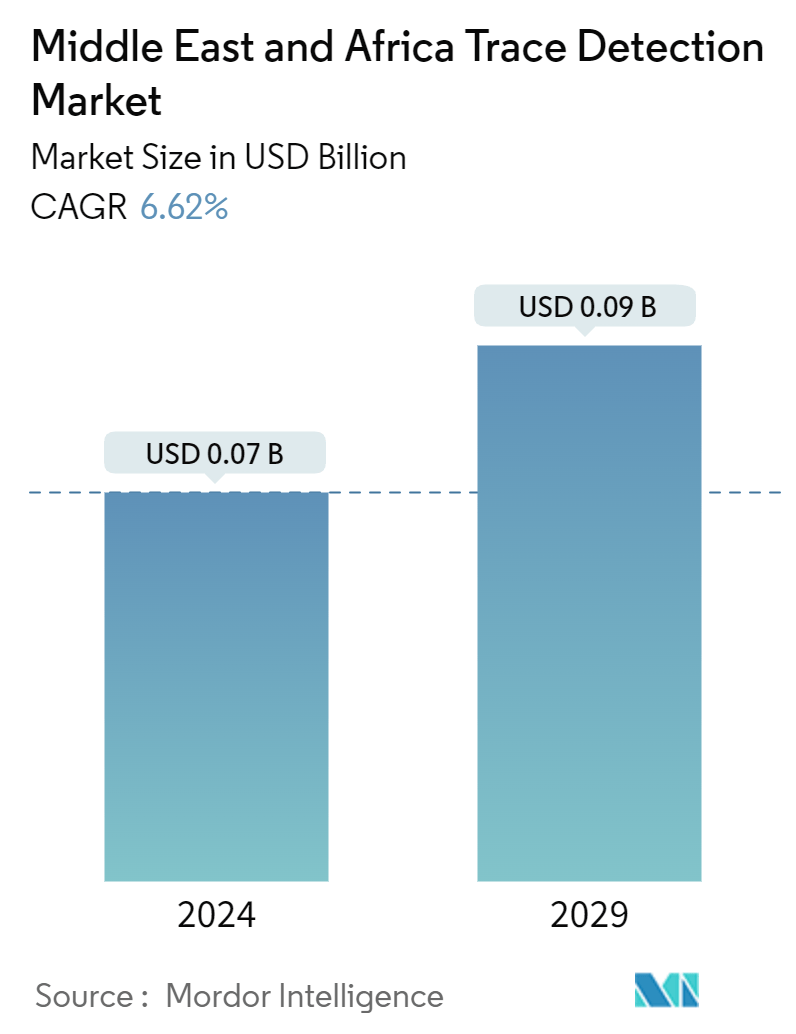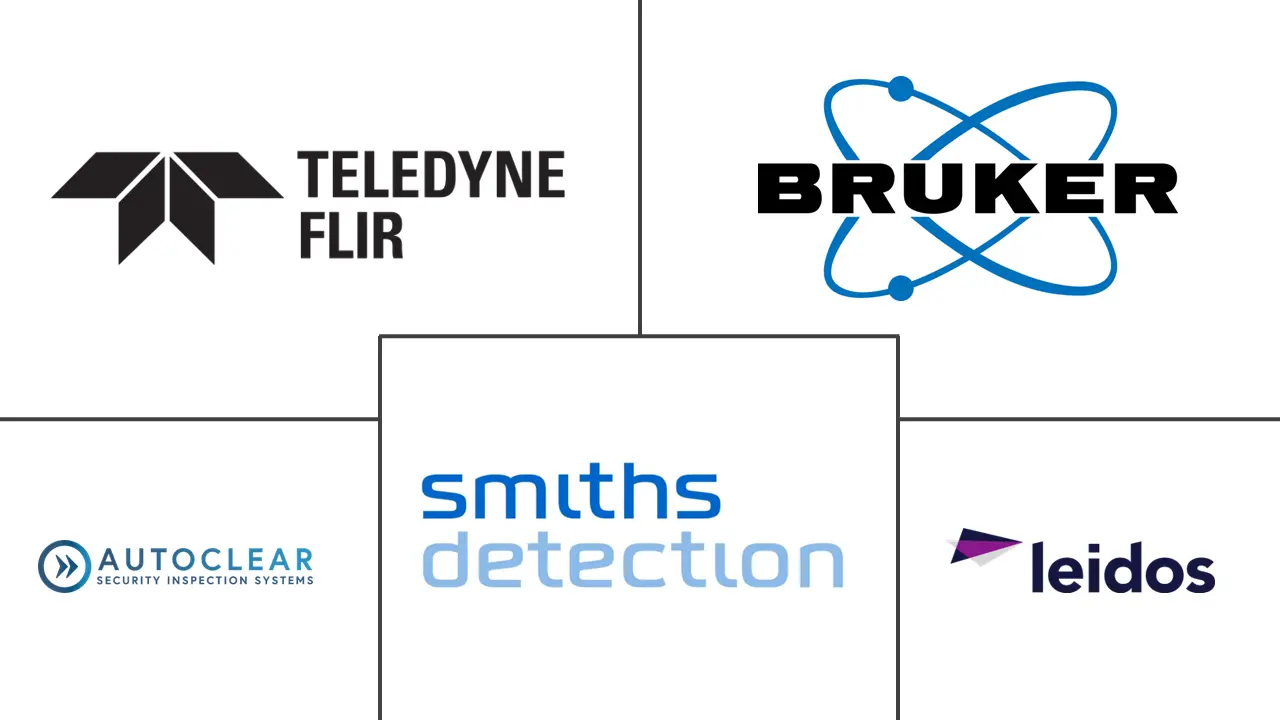Market Size of Middle East And Africa Trace Detection Industry

| Study Period | 2022 - 2029 |
| Base Year For Estimation | 2023 |
| Market Size (2024) | USD 0.07 Billion |
| Market Size (2029) | USD 0.09 Billion |
| CAGR (2024 - 2029) | 6.62 % |
| Market Concentration | Medium |
Major Players
*Disclaimer: Major Players sorted in no particular order |
Middle East And Africa Trace Detection Market Analysis
The Middle East And Africa Trace Detection Market size is estimated at USD 0.07 billion in 2024, and is expected to reach USD 0.09 billion by 2029, growing at a CAGR of 6.62% during the forecast period (2024-2029).
- With the rising terror attack threats at various public gatherings, trace detection plays a vital role, especially for places like government organizations, concerts, schools, transportation, and many others, to help reduce and mitigate associated risk factors.
- Trace detectors can detect and identify extremely low levels of substances, like drugs, chemicals, explosives, or trace elements, in various samples. They are employed in numerous applications like law enforcement, forensics, security, industrial processes, etc. Many trace detectors operate non-destructively. They can also be highly selective in detecting specific substances, allowing for targeted analysis and identification. The increasing use of trace detectors in the military and defense sector, owing to their ability to detect hidden explosives like bombs, improvised explosive devices, chemical warfare agents, etc., is anticipated to drive the growth of the market significantly.
- Trace detection enables assurance from a threat by using various technologies, such as chemiluminescence, amplifying fluorescent polymer, thermo-redox, mass spectrometry, ion mobility spectrometry, automated colorimetric, etc., that are becoming very popular at security checkpoints for expediting the process.
- The increasing gun violence is likely to increase the adoption of trace detectors in the region. For instance, in June 2023, a few gunmen burst into a room at a men's hostel near the eastern South African city of Durban, killing eight people and leaving two others injured. In January 2023, eight people were killed and three others wounded when gunmen opened fire at a birthday party in South Africa's Eastern Cape province.
- In the civil security sector, explosives have been detected mainly by stationary stand-alone devices, such as at airport security gates. The maintenance and cleaning of these devices are very cost-intensive. As a result, portable trace detectors are rapidly gaining popularity in the region. They are designed to operate on battery power, eliminating the need for a constant external power source. This feature makes them suitable for use in remote locations or areas with limited access to electricity. The battery-operated nature of these detectors enhances their mobility and usability. They are user-friendly and offer rapid screening.
- However, explosive trace detectors have varying levels of sensitivity and may not detect trace amounts of explosives. The effectiveness of the detectors can also be influenced by the sampling techniques used. Proper sampling and collection of trace samples are crucial for accurate results. Inadequate sampling may lead to false negatives or false positives. Moreover, failure to calibrate or maintain the equipment can affect its accuracy and reliability. These factors may restrain the growth of the market.
- Furthermore, the implementation and maintenance of trace detection systems can be costly, especially for organizations with limited budgets. The high cost of acquiring and operating screening systems can be costly. Thus, conducting regular training and employing skilled personnel can pose a significant restraint.
- Additionally, the conflict between Russia and Ukraine is expected to impact the electronics industry significantly. The conflict has already exacerbated the semiconductor supply chain issues and the chip shortage that have affected the industry for some time. The disruption may result in volatile pricing for critical raw materials such as nickel, palladium, copper, titanium, aluminum, and iron ore, resulting in material shortages. This, in turn, could impact the manufacturing of various trace detection equipment.
Middle East And Africa Trace Detection Industry Segmentation
Trace detection refers to the process of detecting or identifying minute or trace amounts of a substance or material. Trace detection involves collecting samples from surfaces, objects, or the environment and analyzing them, then using specialized equipment or methods to detect the target substance at very low concentrations.
The trace detection market in the Middle East and Africa is segmented by type (explosive and narcotics), product (handheld, portable/movable, and fixed), end-user industry (commercial, military and defense, law enforcement, ports and borders, public safety, and other end-user industries), and country (United Arab Emirates, Saudi Arabia, South Africa, and Rest of the Middle East and Africa). The report offers the market size and forecasts for all the above segments in value (USD).
| By Type | |
| Explosive | |
| Narcotics |
| By Product | |
| Handheld | |
| Portable/Movable | |
| Fixed |
| By End-user Industry | |
| Commercial | |
| Military and Defense | |
| Law Enforcement | |
| Ports and Borders | |
| Public Safety | |
| Other End-user Industries |
| By Country*** | |
| United Arab Emirates | |
| Saudi Arabia | |
| South Africa | |
| Qatar | |
| Iran | |
| Egypt |
Middle East And Africa Trace Detection Market Size Summary
The Middle East and Africa trace detection market is poised for growth, driven by the increasing need for security measures in response to rising threats such as terrorism and gun violence. Trace detection technology is crucial in various sectors, including government, transportation, and public events, as it can identify minute traces of explosives, drugs, and chemicals. The market is experiencing a shift towards portable, battery-operated devices that offer mobility and ease of use in remote areas. These advancements are particularly relevant in the military and defense sectors, where the detection of hidden explosives and chemical warfare agents is vital. However, challenges such as varying sensitivity levels of detectors, high maintenance costs, and the need for skilled personnel may hinder market expansion.
The market landscape is semi-consolidated, with key players like Smiths Detection Group, Leidos, and Teledyne Flir LLC leading the charge in innovation and product development. The increasing air traffic in regions like Saudi Arabia is expected to further stimulate market growth, as trace detection systems are essential for ensuring security in airports and public transportation. Additionally, the conflict in Ukraine has impacted the electronics industry, potentially affecting the supply chain for trace detection equipment. Despite these challenges, the market is set to benefit from robust military spending and the ongoing demand for advanced security solutions across the Middle East and Africa.
Middle East And Africa Trace Detection Market Size - Table of Contents
-
1. MARKET INSIGHTS
-
1.1 Market Overview
-
1.2 Technology Snapshot
-
1.3 Industry Value Chain Analysis
-
1.4 Industry Attractiveness - Porter's Five Forces Analysis
-
1.4.1 Threat of New Entrants
-
1.4.2 Bargaining Power of Consumers
-
1.4.3 Bargaining Power of Suppliers
-
1.4.4 Threat of Substitute Products
-
1.4.5 Intensity of Competitive Rivalry
-
-
1.5 Impact of COVID-19 Aftereffects and Other Macroeconomic Factors on the Market
-
-
2. MARKET SEGMENTATION
-
2.1 By Type
-
2.1.1 Explosive
-
2.1.2 Narcotics
-
-
2.2 By Product
-
2.2.1 Handheld
-
2.2.2 Portable/Movable
-
2.2.3 Fixed
-
-
2.3 By End-user Industry
-
2.3.1 Commercial
-
2.3.2 Military and Defense
-
2.3.3 Law Enforcement
-
2.3.4 Ports and Borders
-
2.3.5 Public Safety
-
2.3.6 Other End-user Industries
-
-
2.4 By Country***
-
2.4.1 United Arab Emirates
-
2.4.2 Saudi Arabia
-
2.4.3 South Africa
-
2.4.4 Qatar
-
2.4.5 Iran
-
2.4.6 Egypt
-
-
Middle East And Africa Trace Detection Market Size FAQs
How big is the Middle East And Africa Trace Detection Market?
The Middle East And Africa Trace Detection Market size is expected to reach USD 0.07 billion in 2024 and grow at a CAGR of 6.62% to reach USD 0.09 billion by 2029.
What is the current Middle East And Africa Trace Detection Market size?
In 2024, the Middle East And Africa Trace Detection Market size is expected to reach USD 0.07 billion.

